
Even in difficult times of division on the world stage, the Arts Council of Princeton and Muslim Center of Greater Princeton – through art – have found a way to bring local people of different faiths together to talk about spirituality and what each share.
This local event called the “Art of Contemplating Spirituality and Art” is part of the Arts Council of Princeton’s “ART OF” series.
“With everything going on in the world and seeing how divided our world was becoming, I wanted to host an event that would bring all of the communities together especially the Muslim and Jewish communities,” said Samira Ghani, chair of the event and a board trustee of the Arts Council of Princeton.

Dr. Hina Ghory (center) explains her art.
The event took place inside the Muslim Center of Greater Princeton in West Windsor on March 3 and was designed for faith leaders to speak about spirituality and how art resonates with their faith.
“My passion is interfaith and when I’m able to unite us through faith and art, it’s a labor of love for me,” Ghani said. “Seeing all the faiths come together and talk about spirituality, art and love, it truly makes me feel like all the hard work that comes with putting on an event is worth its weight in gold.”
Featuring faith leaders and people from Christian, Muslim, Jewish, Sikh and Buddhist faiths, people in attendance broke bread, listened and had conversations through the Art of Contemplating Spirituality and Art as various works of art were displayed throughout a large multi-purpose room at the mosque.
Faith leaders included Rev. Jan Willem van der Weff from Dutch Neck Presbyterian Church in Princeton Junction, Father Peter Baktis from Mother of God Orthodox Church in Princeton, Amman Seehra, vice chair of the Sikh American Legal Defense and Education Fund (SALDEF), Beverly Sanford from Princeton Buddhist Meditation Group, Rabbi Andrea Merow from the Jewish Center in Princeton and Imam Safwan of the Muslim Center of Greater Princeton. They each shared art that resonates with their faith, spoke about spirituality and connecting with others.
Seehra shared an art piece, “King without a Crown” by Amandeep Singh, who is also known as Inkquisitive Art. He explained through the artwork’s elements how it describes the Sikh faith and the direction of how people should lead their lives.
“The title of this is a ‘King without a Crown.’ The artist wanted to make a distinction between a crown that is man made and given to people and the turban which is a responsibility you take on,” Seehra said. “It is your responsibility to treat yourself and others with respect, but also help those in need.”
He described the three components of what the turban stands for. There was a time when turbans were only worn by royalty and there was the thought that everybody should be treated as royalty, and everybody is deserving of that type of respect, Seehra explained.
“It was essentially for everybody,” he said. “The second meaning is the process of tying [the turban] which should be something you are doing every day and is a constant reminder to do what is good, what is right, and to help others for yourself.”
And third, the turban symbolizes someone being approachable.
“If you see someone with a turban that means you can go to them if you are in need and need help,” he said. “It is a symbol for others to see you are supposed to stick out in a crowd, you are supposed to be there to help others.”

Amman Seehra (right) of the Sikh American Legal Defense and Education Fund (SALDEF) describes the art he presents and its meaning.
Sanford shared what faith means to the Buddhist community and how Buddhist implement this in their everyday lives. She described and explained the art of Rene Magritte in “The Key of the Fields” (La Clef des champs), which is a landscape framed by a window that has been broken.
“We live in a world that is very complicated and full of uncertainty, it always has been and always will be,” she said. “It is very [easy to] hide behind our stories and painted windows and not see the world around us which is so much bigger than we are.”
Sanford expressed that if there is any faith common to all of the Buddhist community, it is the “faith or the confidence that we can wake up and that we can break through, that we can see what our minds are doing. That we can open our hearts wider.
“…When we do …what comes through a broken window, fresh air … Something new and different, something magical even,” she added, noting “life is indeed extraordinary, precious and rare.”
Sanford said that in her Buddhist tradition they believe “we can open our hearts and minds in this messy, sorrowful, glorious, amazing world and find the fresh air in any moment.”

Beverly Sanford (left) from Princeton Buddhist Meditation Group shares on spirituality and art.
Merow, a rabbi from Jewish Center of Princeton, said it was a wonderful process for her to think about art and her spirituality.
“The word spirituality has varied connotations among all our different religions. I define spirituality as an attempt by each of us to encounter the holy one through our actions,” she said.
“The art I want to share with you references and elevates one religious practice, the idea of a Sabbath, a day of rest. For me this painting illustrates spiritual values I want to practice, and my community wants.”
Merow displayed a painting from a series called Hebrew letters by artist Debra Kapnek.
“For me this piece showcases values of universalism, what we share and particularism, our own story,” she said. “Concepts that touch each of us in this room.
“We share the Earth and care for it. We are connected to each other. Each of our religious communities has its own foundational stories. May each of our souls here find the Sabbaths that we need to bring true creativity to this world.”
The Muslim Center of Greater Princeton’s Imam Safwan expressed that “what gives light is the presence of truth inside of it.”
“We live when we make meaning and art brings us closer to those essential meanings and truths,” Safwan said. “That beauty, that love, so what I have chosen for my art is mamluk architecture. Mamluk society was part of the great Ottoman movement within what we could call the golden society of Islam.”
He explained how mamluk architecture created spaces with beauty in every point and function. The art of the building preserves its legacy and function.
“People behold these spaces for us to just ponder on its beauty and beauty of its people,” Safwan said. “Ultimately, the message I wish to close with is that buildings are generally not preserved for function. What makes something a legacy is the meaning that sustains it, not its function.
“The meaning will pay off generationally in the preservation of beauty.”

